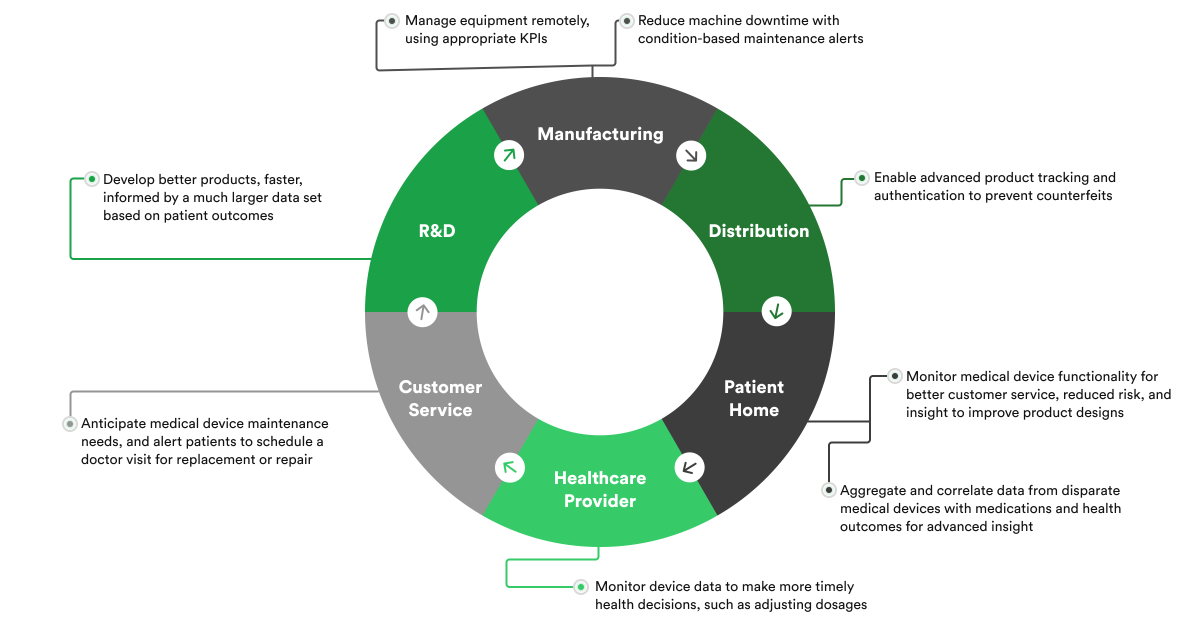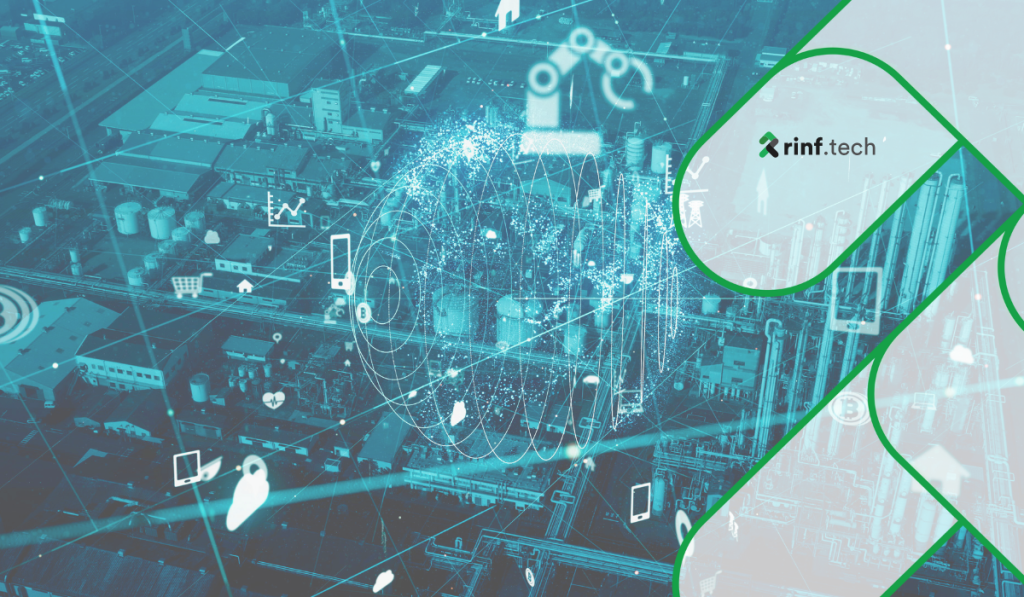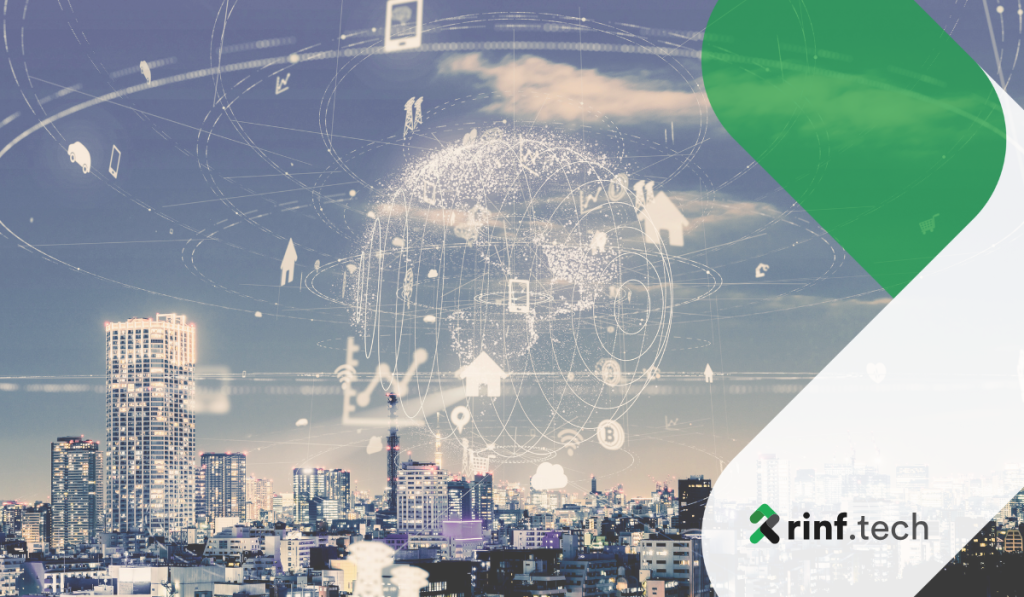
How IoT is Revolutionizing Agriculture: Key Innovations and Future Prospects
Discover how IoT is transforming traditional farming through key innovations, real-world success stories, and future trends that are shaping the agricultural sector.
With the global IoT in the healthcare market expected to reach $305.55 billion by 2032, the potential for transformation across the healthcare sector is immense. This growth is driven by increased demand for reduced healthcare costs, improved patient outcomes, and enhanced healthcare delivery.
Key applications such as remote patient monitoring, telehealth, and supply chain visibility are not just futuristic concepts but are currently being implemented, showing promising results in increasing accessibility, predictive healthcare, and operational efficiency.
This article delves into these applications, showcasing the tangible benefits IoT brings to the healthcare sector, from enhancing patient engagement and monitoring to optimizing supply chains and operational workflows.
The Remote Patient Monitoring (RPM) field is witnessing a remarkable expansion due to IoT’s ability to offer continuous, accurate, and real-time tracking of patient health data. This innovation marks a significant deviation from traditional healthcare models, focusing on a proactive approach to patient care. Remote patient monitoring leverages technology to collect and transmit patients’ health data from their homes or outside a clinical setting. This approach offers multiple benefits for both patients and healthcare providers. Patients enjoy greater autonomy in managing their health, with features like medication reminders and the ability to track vitals in real time. For providers, RPM translates to earlier detection of potential health issues, allowing for preventative measures and improved care coordination. Nearly 90% of healthcare providers have already invested or plan to invest in RPM solutions, highlighting this technology’s significant growth and acceptance.
At the heart of RPM are IoT devices. These come in various forms, including smartwatches with built-in health sensors, wearable patches that monitor vitals continuously, and intelligent blood pressure cuffs that transmit readings wirelessly. This network of devices goes beyond basic vitals like heart rate and temperature. Advanced sensors can track medication adherence by monitoring pill dispenser usage, while intelligent scales can detect sudden weight fluctuations that might indicate fluid buildup or other health concerns.
The true power of RPM lies in real-time data collection and analysis. With continuous information streams, healthcare providers can proactively identify trends and potential health complications. Imagine a scenario where a patient’s smartwatch detects an irregular heartbeat. This data can be instantly relayed to a doctor, allowing for a timely intervention, and potentially preventing a more severe episode. This proactive approach to healthcare paves the way for improved patient outcomes and a more efficient healthcare system.
Integrating IoT with telehealth represents a pivotal evolution in healthcare delivery, transforming access to medical services and enhancing patient care quality. The global telemedicine market is expected to reach $431,823.81 million by 2030, up from $40,205.68 million in 2020. According to the report, 90% of the survey respondents have already started adopting telemedicine programs. Also, the American Hospital Association estimated that 74% of US patients used telehealth services through IoT devices in 2023, thus reflecting the industry’s fast expansion. As the statistics predict, digital health solutions are increasingly essential in addressing the healthcare industry’s challenges. This growth is driven by the need to reduce healthcare costs, the convenience of remote care, and the global rise in chronic diseases coupled with an aging population.
Telehealth, empowered by IoT, extends the reach of healthcare services to remote and underserved communities, eliminating geographical barriers and making healthcare more inclusive. Devices such as connected thermometers, blood pressure monitors, and wearable fitness trackers feed vital health data directly into telehealth platforms. This seamless integration enables healthcare professionals to conduct comprehensive remote consultations, closely monitor patient health, and make informed decisions without needing physical presence.
This technology-driven approach to healthcare delivery is particularly beneficial in managing chronic conditions, where continuous monitoring can significantly impact outcomes. It also plays a critical role in post-surgical care, mental health, and elderly care, offering patients the comfort of receiving high-quality care from their homes. Moreover, the ability to analyze vast amounts of data collected through IoT devices enhances healthcare providers’ predictive capabilities, leading to early detection of potential health issues and customized care plans.
The adoption of IoT in telehealth also addresses some of the most pressing issues facing healthcare systems today, including the need to manage increasing patient loads and the emphasis on cost-effective care delivery. By leveraging technology to streamline processes and improve patient engagement, telehealth is setting a new standard for healthcare in the digital age. As this integration heightens, it promises to improve health outcomes and reshape the field of healthcare delivery, making it more accessible, efficient, and patient-centered.

In the complex healthcare ecosystem, efficient supply chain and inventory management are pivotal for operational excellence and patient care quality. The advent of IoT has introduced a transformative solution to traditional supply chain challenges, enabling remarkable levels of visibility, control, and efficiency.
Integrating IoT technology for hospital supply chain tracking and inventory management not only streamlines operations but also ensures the optimal use of resources, significantly reducing waste and costs. Real-time monitoring of medications, equipment, and supplies through IoT devices and sensors allows for automated inventory management, minimizing the risks of stockouts or overstocking. This precision in managing resources directly translates into improved patient care, as the necessary tools and treatments are always readily available when needed.
We at rinf.tech have first-hand experience implementing IoT technologies in this field. One of our clients, a global electronics manufacturer, needed help developing an inventory management tracker for hospitals. They sought our help to build a custom smart consignment inventory management (SCIM) platform to deliver consignment items to the hospital. This technology not only tracks the location of equipment within healthcare facilities but also monitors usage rates and maintenance schedules, ensuring that medical devices are operational and available when patients need them most. This example is a testament to how IoT connectivity can redefine inventory control, offering healthcare providers a granular view of their assets in real-time.
Similarly, another project we worked on was developing a global content portal for the healthcare supply chain. We designed and built a platform as a single source of truth (SSOT) for item data for all company product offerings that is stable, scalable, and reliable. This portal stands as a critical tool in the fight against inefficiencies, enabling healthcare facilities to navigate the complexities of supply chain management with ease and precision. This solution illustrates the power of IoT in enhancing transparency and efficiency across the healthcare ecosystem. Healthcare providers can optimize their operations, reduce costs, and ultimately deliver better patient care by providing a centralized platform for tracking and managing the supply chain.
While the integration of IoT in healthcare brings a new era of efficiency, accessibility, and personalized care, it also introduces challenges and considerations that must be addressed to fully harness its potential.
Data security and privacy concerns are the first to come to mind among these challenges, given the sensitive nature of patient health information. As a prime target for cyberattacks, the healthcare industry needs robust security protocols to protect against data breaches and ensure patient confidentiality. In 2023, 88% of healthcare organizations experienced cyberattacks, with an average of 40 attacks over the past 12 months, costing organizations around $4.9 million for the most expensive attack.
Device interoperability emerges as another significant limitation. With many IoT devices and platforms in healthcare, ensuring seamless communication and integration among these systems is important for efficient operations and effective patient care. The lack of standardization across devices can lead to fragmented data and restrict the holistic view of patient health, thereby complicating treatment decisions.
Another consideration is the digital divide, which could widen due to unequal access to IoT technologies. While urban and affluent populations may benefit from the advancements in healthcare IoT, rural and underserved communities might face challenges in accessing these technologies, thereby aggravating health differences.
Efforts to address these challenges are ongoing, with industry stakeholders and regulatory bodies working towards establishing data security, privacy, and device interoperability standards. For instance, initiatives such as the Health Insurance Portability and Accountability Act (HIPAA) in the United States aim to safeguard patient data, while organizations like the Continua Health Alliance work towards improving interoperability among health devices and systems.
The integration of IoT in the healthcare sector marks a transformative shift towards more accessible, efficient, and personalized medical care. By enabling remote patient monitoring, enhancing telehealth services, and optimizing hospital supply chain and inventory management, IoT technologies are augmenting existing healthcare practices and redefining the paradigms of care delivery and patient engagement.
The significant growth and investment in healthcare IoT emphasizes its potential to address some of the most pressing challenges in healthcare today, including managing chronic diseases, delivering care in remote areas, and efficiently utilizing resources.
However, the journey towards realizing the full potential of IoT in healthcare is complex and paved with challenges such as ensuring data privacy, achieving device interoperability, and bridging the digital divide. These constraints emphasize the necessity for expertise, innovation, and collaboration. As healthcare organizations navigate these scenarios, the importance of partnering with technology experts who can guide the integration of IoT solutions cannot be overstated. These partnerships are pivotal in developing secure, compliant, and effective digital health solutions that leverage the power of IoT to meet the unique needs of patients and healthcare providers alike.

Discover how IoT is transforming traditional farming through key innovations, real-world success stories, and future trends that are shaping the agricultural sector.

Delving into the IoT device onboarding requirements, challenges and implementation best practices across smart home, industrial, and healthcare settings.

Delving into the complexities of AIoT, exploring its core principles, current state, challenges, and future trends.
Copyright © 2023 rinf.tech. All Rights Reserved.
Terms & Conditions. Cookie Policy. Privacy Policy.
Politica Avertizari de Integritate (RO)